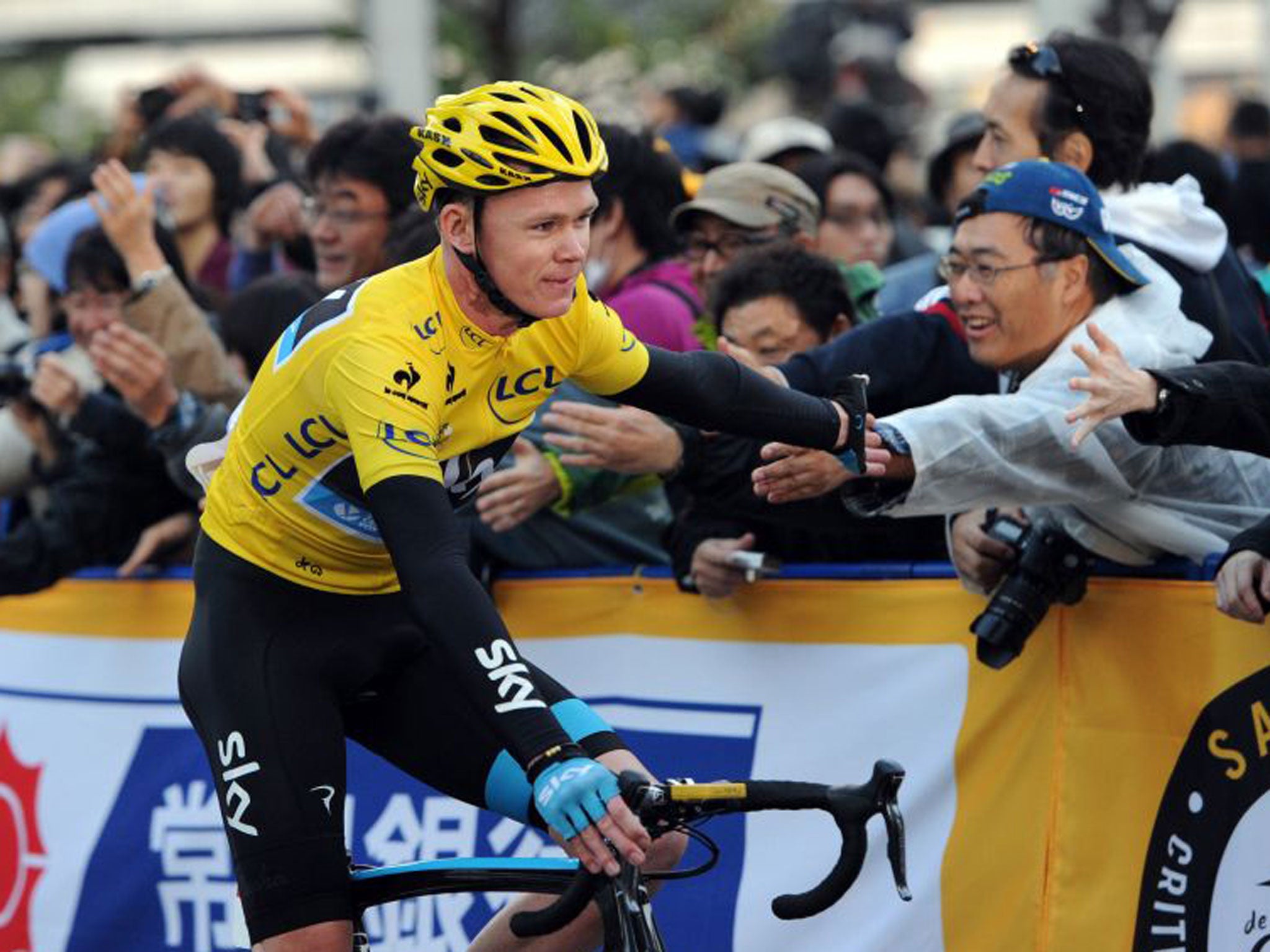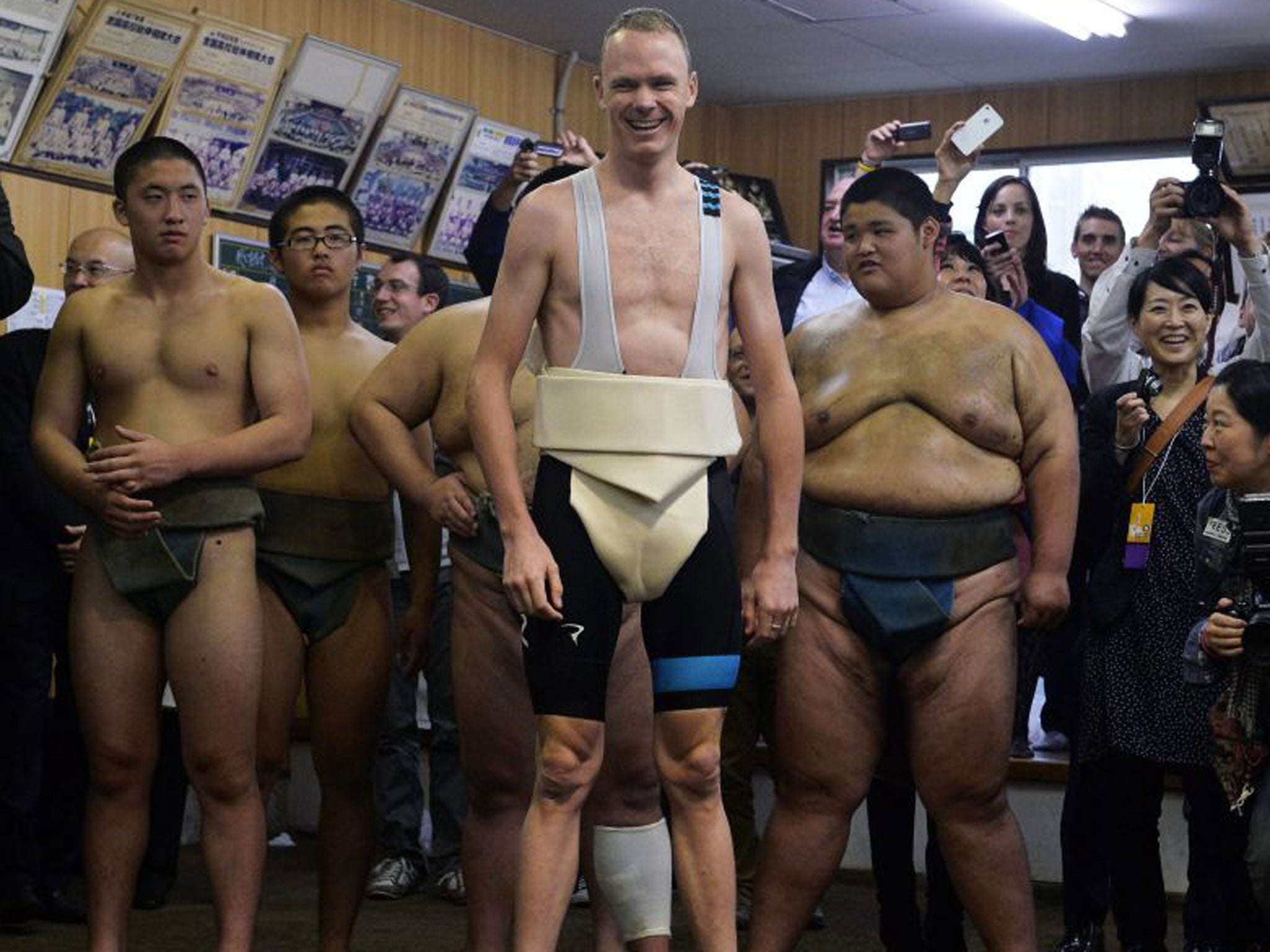Japan turns out for a spot of Va-Va-Froome
Yellow jersey winner Chris Froome enjoys unexpected celebrity status as the Tour de France road show taps into growing Far East market

Your support helps us to tell the story
From reproductive rights to climate change to Big Tech, The Independent is on the ground when the story is developing. Whether it's investigating the financials of Elon Musk's pro-Trump PAC or producing our latest documentary, 'The A Word', which shines a light on the American women fighting for reproductive rights, we know how important it is to parse out the facts from the messaging.
At such a critical moment in US history, we need reporters on the ground. Your donation allows us to keep sending journalists to speak to both sides of the story.
The Independent is trusted by Americans across the entire political spectrum. And unlike many other quality news outlets, we choose not to lock Americans out of our reporting and analysis with paywalls. We believe quality journalism should be available to everyone, paid for by those who can afford it.
Your support makes all the difference.The Tour de France is July’s spectacle, but 2013 winner Chris Froome and the boys of summer reprised their roles for a travelling performance on Saturday here on the streets of Saitama, a peaceful city just north of Tokyo, renowned for its bonsai gardens and cherry blossoms.
The inaugural Saitama Criterium by Le Tour de France was billed as “the 22nd stage of the Tour” and little expense was spared in persuading 32 of the stars of the European-based peloton to make the trek to Japan, with world champion Rui Costa, Tour de France green jersey Peter Sagan and former Giro d’Italia winner Ivan Basso among those joining Froome for the exhibition race.
Indeed, but for the backdrop of towering skyscrapers juxtaposed against the rosy-hued skies of autumn, some of the scenes could have been lifted directly from the Tour itself. Froome again donned the maillot jaune, the distinctive yellow neutral support car followed the peloton and, just like in July, the podium ceremonies were sternly marshalled by the badgering presence of five-time Tour winner Bernard Hinault.
Before an estimated attendance of 200,000, Froome and company raced against a selection of Japanese riders on a 2.6km-long city centre circuit, as part of a venture designed by Tour de France owner ASO to promote the race in a market where the appetite for cycling has grown steadily in recent years. “I’m amazed at how many people follow cycling here,” Froome said. “I didn’t expect to be recognised at the airport or on the street.”
Such knowledge is thanks in part to the exploits of Yukiya Arashiro and Fumiyuki Beppu, who in 2009 became the first Japanese riders to finish the Tour – previous entrants in 1926, 1927 and 1996 had failed to reach Paris – a feat that has led to a surge in coverage on Japanese television.
“Everybody knows the name ‘Tour de France’ in Japan but they don’t necessarily know how it works or what it really consists of,” said Arashiro, who has since completed three more Tours and was among the main draws in Saitama. “This is a big chance for the Japanese public to see the peloton up close.”
A real Tour stage on the other side of the world would be a logistical impossibility but the Saitama exhibition, it seems, is the next best thing. “This is the first event outside of the Tour itself to bear the name ‘Tour de France’,” said ASO president Jean-Etienne Amaury. “Our aim was to come here and recreate the combination of sporting competition and popular festival that we see at the Tour.”
As at the Tour, the crowd was a blend of committed fans in full cycling kit and casual observers enjoying a curious spectacle, and an array of stalls catered to both elements by hawking French food and Tour-branded merchandise as the race whizzed by. Japan has a longstanding cycling tradition of its own, which prospered independently of developments in the sport’s European heartland. The keirin, the track event dominated by Chris Hoy at recent Olympic Games, was invented here, although its popularity in its country of origin owes less to De Coubertin ideals than to the betting industry that built up around it.
Until relatively recently, “keirin” and “cycling” were essentially interchangeable terms in Japan, and the Saitama Criterium duly incorporated local custom. The proceedings began with a pair of keirin-style races in which points were awarded to the first five riders at the end of every other lap. On each occasion, the honours fell to home riders, Yusuke Hatanaka and Yasuharu Nakajima, while their guests gingerly felt their way around a circuit made greasy by morning rain. The day before the race, the Tour contingent had been gently introduced to another local sporting tradition, when Froome led a delegation of riders who donned the sumo belt, or mawashi, over their cycling shorts and clambered into the ring with young wrestlers for a photo opportunity at a local high school.
Other realities of the region were rather less inviting. The effects of Typhoon Francisco meant the threat of cancellation loomed when the riders arrived in Japan on Thursday, while they were stirred from their sleep on the eve of the race by a force 7.5 earthquake that shook their hotel for several minutes.
Calm reigned when the riders descended to the lobby on Saturday morning, however, where they were greeted by an orderly queue of fans, patiently lining up for autographs behind a velvet rope. “Sometimes fans can be a bit abrupt at races, but here they’re just really enthusiastic and polite as well,” Sky’s Geraint Thomas said.
After the initial points races, the main event, a 40-lap criterium, followed a familiar pattern. Each August, towns across Europe pay for the protagonists of the Tour to come and participate in such exhibition races, which follow a convention not unlike that of a football testimonial match – the tacit understanding is that the crowd will be sent home happy.
So it was in Saitama, as the Tour’s leading players trod the boards for one final curtain call before the end of the season. Most of the ensemble had a chance to take a bow, and the most popular such vignette was that of Japanese Tour pioneer Beppu, who zipped off the front with five laps to go.
His efforts helped turn the earlier genteel applause into more raucous cheering, and when he was caught, it was no surprise to see Froome, the rainbow jersey Costa and green jersey Sagan attack together in the finale. Nor was it unexpected, at least in this context, to see Froome ride solo to victory.
As well as hitting his lines during the criterium, Froome was careful to strike the right tone in his ambassadorial role afterwards. “I have to try and win the Tour de France again first, but yes, I would like very much to come back here in the yellow jersey,” he told a television crew.
And long after darkness had descended on Saitama, Froome remained behind the podium signing autographs, the final duties of a year in yellow.

Join our commenting forum
Join thought-provoking conversations, follow other Independent readers and see their replies
Comments